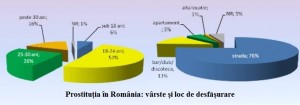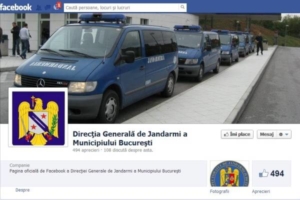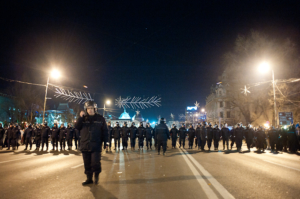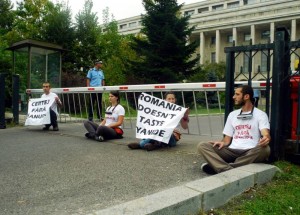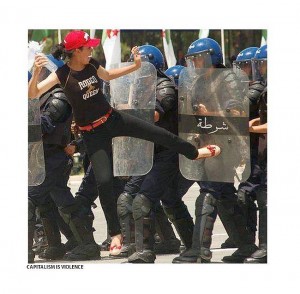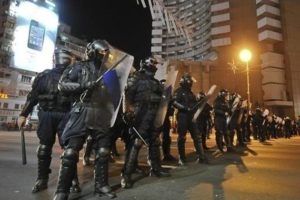Propunerile APADOR-CH de modificare a Constituţiei, adresate Forumului Constituţional
Prin Hotărârea Parlamentului nr. 17/2013 a fost constituită Comisia comună a Camerei Deputaţilor şi Senatului pentru elaborarea propunerii legislative de revizuire a Constituţiei României.
Potrivit art. 3 al. 1 din Hotărârea Parlamentului nr.17/2013 şi art.8 alin.1 din Regulamentul de organizare şi funcţionare a Comisiei comune (aprobat prin Hotărârea nr.1 din 27 februarie 2013 a Birourilor permanente ale Camerei Deputaţilor şi Senatului), tezele revizuirii Constituţiei vor fi stabilite de către Comisie, pe baza propunerilor primite de la grupurile parlamentare.
În lipsa unui calendar anunţat public al revizuirii Constituţiei şi deşi nu face parte din vreun grup parlamantar, APADOR-CH îşi prezintă mai jos propunerile cu privire la anunţata revizuire a Constituţiei.
Nr. crt.
Text iniţial
Text propus
Motivare
1.
ARTICOLUL 23
Libertatea individuală
(8) Celui reţinut sau arestat i se aduc de îndată la cunoştinţă, în limba pe care o înţelege, motivele reţinerii sau ale arestării, iar învinuirea, în cel mai scurt termen; învinuirea se aduce la cunoştinţă numai în prezenţa unui avocat, ales sau numit din oficiu.
(9) Punerea în libertate a celui reţinut sau arestat este obligatorie, dacă motivele acestor măsuri au dispărut, precum şi în alte situaţii prevăzute de lege.
“ (8) Celui condus administrativ , reţinut sau arestat i se aduc de îndată la cunoştinţă, în limba pe care o înţelege, motivele conducerii adminstrative, ale reţinerii sau ale arestării, iar învinuirea, în cel mai scurt termen; învinuirea se aduce la cunoştinţă numai în prezenţa unui avocat, ales sau numit din oficiu.
(9) Punerea în libertate a celui condus administrativ , reţinut sau arestat este obligatorie, dacă motivele acestor măsuri au dispărut, precum şi în alte situaţii prevăzute de lege.”
Modificarea este necesară în vederea instituirii unor minime garanţii privind respectarea drepturilor persoanelor conduse administrativ la sediul poliţiei, potrivit art. 31 lit. b) din Legea nr. 218/2002 (privind organizarea şi funcţionarea Poliţiei Române). Aceste persoane conduse administrativ sunt, în sensul Protocolului Opţional la Convenţia Împotriva Torturii, ratificat de România prin Legea nr. 109/2009, persoane private de libertate la fel ca şi persoanele reţinute sau arestate. În acest sens, art. 4 al. 2 din Protocol prevede: „ În sensul prezentului protocol, privarea de libertate înseamnă orice formă de detenţie sau închisoare ori plasarea unei persoane într-un loc public sau privat de reţinere pe care nu îl poate părăsi după voia sa, prin ordinul oricărei autorităţi judiciare, administrative sau de altă natură .”
Pentru garantarea respectării Protocolului Opţional la Convenţia Împotriva Torturii, ratificat de România prin Legea nr. 109/2009, este absolut necesar ca orice referire constituţională la persoana reţinută sau arestată să fie completată şi cu referirea la persoana condusă administrativ.
1.
ARTICOLUL 24
Dreptul la apărare
(2) În tot cursul procesului, părţile au dreptul să fie asistate de un avocat, ales sau numit din oficiu.
“(2) În tot cursul procesului, părţile au dreptul să fie asistate de un avocat, ales sau numit din oficiu şi de a dispune de timpul şi înlesnirile necesare pentru pregătirea apărării .”
Completarea art. 2 cu prevederea dreptului părţii de a dispune de timpul şi înlesnirile necesare pentru pregătirea apărării sale. Prevederi în acest sens există şi în art. 6 din CEDO, dar instanţele naţionale se rezumă de multe ori la asigurarea prezenţei avocatului, fără a mai fi preocupate şi de acordarea timpului şi înlesnirilor necesare apărării.
2.
ARTICOLUL 26
Viaţa intimă, familială şi privată
Se introduce alin. (3)
“ (3) Orice măsură de supraveghere a unei persoane trebuie adusă la cunoştinţa acesteia în cel mult 180 de zile de la data încetării . ”
Este necesară prevederea în Constituţie a unei garanţii pentru respectarea şi ocrotirea vieţii intime, familiale şi private. Cea mai eficientă garanţie este obligaţia autorităţilor publice de a aduce la cunoştinţa persoanei că a fost supravegheată. Odată înştiinţată, persoana poate urma procedurile pe care le consideră potrivite pentru repararea unor eventuale abuzuri. Obligaţia de încunoştinţare a persoanei vizate, într-un termen rezonabil de la data încetării supravegherii, termen care nu poate depăşi 180 zile de la data încetării supravegherii, reprezintă o măsură care va mai tempera abuzul de supraveghere.
3.
ARTICOLUL 30
Libertatea de exprimare
(2) Cenzura de orice fel este interzisă.
(3) Libertatea presei implică şi libertatea de a înfiinţa publicaţii.
(4) Nici o publicaţie nu poate fi suprimată.
(5) Legea poate impune mijloacelor de comunicare în masă obligaţia de a face publică sursa finanţării.
(6) Libertatea de exprimare nu poate prejudicia demnitatea, onoarea, viaţa particulară a persoanei şi nici dreptul la propria imagine.
(7) Sunt interzise de lege defăimarea ţării şi a naţiunii, îndemnul la război de agresiune, la ură naţională, rasială, de clasă sau religioasă, incitarea la discriminare, la separatism teritorial sau la violenţă publică, precum şi manifestările obscene, contrare bunelor moravuri.
(8) Răspunderea civilă pentru informaţia sau pentru creaţia adusă la cunoştinţă publică revine editorului sau realizatorului, autorului, organizatorului manifestării artistice, proprietarului mijlocului de multiplicare, al postului de radio sau de televiziune, în condiţiile legii. Delictele de presă se stabilesc prin lege.
“(2) Cenzura de orice fel este interzisă. N icio altă măsură prin care se împiedică publicarea sau difuzarea unei opinii, informaţii sau idei nu se va putea dispune .
(3) Libertatea presei implică şi libertatea de a înfiinţa mijloace de comunicare în masă .
(4) Niciun mijloc de comunicare în masă nu poate fi suspendat sau suprimat.
(5) Mijloacele de comunicare în masă au obligaţia de a declara public sursa finanţării. Procedura declarării se stabileşte prin lege.
(6) Libertatea de exprimare nu poate prejudicia demnitatea, onoarea, viaţa privată a persoanei şi nici dreptul la propria imagine, cu excepţia discutării cu bună-credinţă a chestiunilor de interes public .
(7) Sunt interzise de lege, îndemnul la război de agresiune, la ură naţională, rasială, de clasă sau religioasă, incitarea la discriminare, la separatism teritorial sau la violenţă publică, precum şi manifestările obscene .
(8) Răspunderea civilă pentru informaţia sau pentru creaţia adusă la cunştinţa publică revine, după caz , editorului sau realizatorului, autorului, organizatorului manifestării artistice, proprietarului mijlocului de multiplicare, al postului de radio sau de televiziune, în condiţiile legii.”
Constituţia nu poate să prevadă pentru libertatea de exprimare un regim mai strict/sever decât cel prevăzut de art. 10 din Convenţia Europeană a Drepturilor Omului. În acest sens, art. 20 al. 2 din Constituţie prevede că dacă există neconcordanţe între pactele şi tratatele privitoare la drepturile fundamentale ale omului, la care România este parte, şi legile interne, au prioritate reglementările internaţionale, cu excepţia cazului în care Constituţia sau legile interne conţin dispoziţii mai favorabile.
Sub acest aspect, art. 30 al. 6 din Constituţie contravine art. 10 din Convenţie şi jurisprudenţei CEDO privind libertatea de exprimare, potrivit căreia, în cazul în care sunt dezbătute, cu bună-credinţă, chestiuni de interes public, libertatea de exprimare include şi dreptul de a exagera, de a ofensa, de a şoca sau deranja. Protejarea onoarei şi reputaţiei politicienilor sau guvernanţilor nu are caracter absolut (astfel cum rezultă din actualul art. 30 al. 6 din Constituţie), ci, dimpotrivă, potrivit jurisprudenţei CEDO, această protecţie nu există în cazul discutării cu bună-credinţă a chestiunilor de interes public.
Tot în jurisprudenţa CEDO s-a statuat că şi “defăimarea ţării sau naţiunii” sunt admise în cazul în care sunt dezbătute, cu bună-credinţă, chestiuni de interes public. Libertatea de exprimare presupune şi dreptul de a exagera, de a ofensa, de a şoca sau deranja. Sub acest aspect, şi art. 30 al. 7 din Constituţie contravine art. 10 din Convenţie şi jurisprudenţei CEDO privind libertatea de exprimare. Pe lângă sintagma “defăimarea ţării sau naţiunii”, din art. 30 al. 7 trebuie eliminată şi sintagma “bune moravuri”, întrucât noţiunea de “bune moravuri” este ambiguă şi greu de cuantificat, lăsând loc unor interdicţii arbitrare.
De asemenea, trebuie revenit la înţelepciunea Constituţiei din 1923, cel puţin cu privire la art. 25 al. 3, care prevedea că “ Nici cenzura , nici o altă măsură preventivă pentru aparţtiunea, vinderea sau distribuţiunea oricărei publicaţiuni nu se va putea înfiinţa.” şi la art. 25 al. 6, care prevedea că “ Nici un ziar sau publicaţiune nu va putea fi suspendat sau suprimat.” Deci, în cazul presei, nu numai suprimarea trebuie interzisă, ci şi suspendarea.
Totodată, trebuie eliminată confuzia din art. 30 al. 3 şi 4, care identifică şi, astfel, reduce întreaga presă la presa scrisă, la publicaţii, tipărituri. Actualele dispoziţii constituţionale ignoră că, în prezent, presa nu se mai rezumă la publicaţii (= tipărituri = cărţi, reviste, ziare) şi, din acest motiv, nu acoperă componenta audio-vizuală a presei. De aceea, noţiunea de “publicaţie” trebuie înlocuită cu “mijloc de comunicare în masă”, care include şi presa audio-vizuală.
Pentru asigurarea transparenţei, este necesară introducerea în Constituţie a obligaţiei declarării publice a sursei de finanţare a m ijloacelor de comunicare în masă. Procedura declarării urmează să fie stabilită prin lege.
Din art. 30 al. 8 trebuie eliminată propoziţia finală “ Delictele de presă se stabilesc prin lege ”. Această prevedere este redundantă şi poate crea confuzii, întrucât orice infracţiune, în orice materie, se stabileşte doar prin lege. De asemenea, pentru acurateţe, trebuie precizat că răspunderea numeroaselor persoane enumerate în al. 8 intervnie nu simultan, ci “după caz”.
ARTICOLUL 31
Dreptul la informaţie
Se introduc al. 2/1şi 3 /1.
“(2/1) – Orice persoană juridică este obligată să facă public, din oficiu, toate bunurile, lucrările sau serviciile achiziţionate prin folosirea de fonduri sau resurse publice, inclusiv procedura urmată şi costurile pentru fiecare achiziţie ”
“ (3/1) – Nicio excepţie nu va putea fi opusă dreptului de acces la o informaţie de interes public, dacă există un interes public major care depăşeşte interesul ocrotit pe cale de excepţie .”
Prevederea din al. 2 care instituie obligaţia autorităţilor de a asigura informarea corectă a cetăţenilor asupra treburilor publice trebui completată, pentru ca aceasta să devină şi eficientă cu obligaţia constituţională de declarare, din oficiu, a tuturor achiziţiilor din fonduri/resurse publice. Creşterea gradului de tansparenţă privitor la folosirea banului public va contribui substanţial la informarea corectă a cetăţenilor asupra treburilor publice.
De asemenea, Constituţia trebuie să prevadă o situaţie în care nicio excepţie nu poate fi opusă dreptului de acces la informaţii. Atunci când există un interes public major de a cunoaşte o informaţie, acea informaţie trebuie facută public, indiferent de interesul care este ocrotit prin interdicţia de difuzare a acelei informaţii. Spre exemplu, atunci când o informaţie priveşte un pericol important la adresa sănătăţii publice, nicio excepţie de la liberul acces la acea informaţie (nici protejarea secretului de stat) nu poate fi opusă dreptului de acces la acea informaţie.
Pentru aceste motive, APADOR-CH propune introducerea a 2 noi alineate, dupa al. 2 şi după al. 3.
4.
ARTICOLUL 39
Libertatea întrunirilor
Se introduce alin. (2)
“ (2) Organizarea şi desfăşurarea unei adunări publice nu pot fi condiţionate de existenţa unei notificări sau aprobări prealabile .”
Actuala reglementare constituţională este eliptică şi permite ca libertatea întrunirilor să fie grav şi substanţial diminuată prin lege, care instituie un parcurs birocratic foarte complicat şi greu de urmat, în cazul în care se doreşte participarea la o adunare publică.
Constituţia trebuie să conţină o prevedere clară în sensul interzicerii piedicilor birocratice pentru organizarea şi desfăşurarea unei adunări publice.
5.
ARTICOLUL 70
Mandatul deputaţilor şi al senatorilor
(2) Calitatea de deputat sau de senator încetează la data întrunirii legale a Camerelor nou alese sau în caz de demisie, de pierdere a drepturilor electorale, de incompatibilitate ori de deces.
Se introduce alin. (3)
“(2) Calitatea de deputat sau de senator încetează la data întrunirii legale a Camerelor nou alese sau în caz de demisie, de revocare , de pierdere a drepturilor electorale, de incompatibilitate ori de deces.
(3) Derularea procedurii de revocare nu poate fi condiţionată decât de întrunirea unui număr de solicitări din partea cetăţenilor din circumscripţia electorală respectivă, reprezentând minimum 2/3 din numărul voturilor cu care a fost ales parlamentarul, şi se va finaliza printr-un referndum, care nu necesită cvorum .”
Este necesară prevederea în Constituţie a posibilităţii revocării parlamentarilor de către cetăţeni, precum şi câteva repere ale unei proceduri simple şi eficiente de revocare.
Aşa cum cetăţeanul, când alege un parlamentar, nu trebuie să-şi justifice opţiunea sa, ci este suficient să-şi exprime votul, tot aşa şi atunci când apreciază ca parlamentarul pe care l-a ales nu-l mai reprezintă, cetăţeanul trebuie să-l poată revoca, fără alte justificări, motivări, explicaţii, în afara votului pe care şi-l exprimă pentru revocare. Consecinţa directă este că parlamentarul va trebui să redevină atent la interesele şi nevoile cetăţeanului care l-a votat şi că această atenţie va trebui să şi-o păstreze pe durata întregului mandat, nu doar în pragul alegerilor. Constituţia ar trebui să prevadă că revocarea parlamentarului poate fi cerută de un anumit număr de alegători (de exemplu, număr egal cu 2/3 din numărul voturilor cu care a fost ales parlamentarul) din circumscripţia electorală respectivă şi că se va finaliza printr-un referendum care nu necesită cvorum. De asemenea, Constituţia trebuie să prevadă că dacă numărul de semnături pentru iniţierea referendumului de revocare a parlamentarului este îndeplinit, nici o altă condiţie nu mai este necesară pentru declanşarea referendumului.
6.
ARTICOLUL 96
Punerea sub acuzare
(1) Camera Deputaţilor şi Senatul, în şedinţă comună, cu votul a cel puţin două treimi din numărul deputaţilor şi senatorilor, pot hotărî punerea sub acuzare a Preşedintelui României pentru înaltă trădare.
(2) Propunerea de punere sub acuzare poate fi iniţiată de majoritatea deputaţilor şi senatorilor şi se aduce, neîntârziat, la cunoştinţă Preşedintelui României pentru a putea da explicaţii cu privire la faptele ce i se impută.
“(1) Camera Deputaţilor şi Senatul, în şedinţa comună, cu votul a cel puţin două treimi din numărul deputaţilor şi senatorilor, pot încuviinţa urmărirea penală, trimiterea în judecată penală, percheziţionarea, reţinerea sau arestarea Preşedintelui României pentru fapte care nu au legătură cu voturile sau cu opiniile politice exprimate în exercitarea mandatului.
(2) Propunerea de urmărirea penală, trimiterea în judecată penală, percheziţionarea, reţinerea sau arestare se aduc, neîntârziat, la cunoştinţa Preşedintelui României pentru a putea da explicaţii cu privire la faptele ce i se impută. ”
Art. 96 al. 1 trebuie modificat în sensul că trebuie prevăzut pentru preşedinte un regim similar cu cel al parlamentarilor : preşedintele să poată fi pus sub acuzare (mai precis, urmărit penal), percheziţionat, reţinut sau arestat în condiţiile art. 96 al. 1, dar cu înlocuirea expresiei “înaltă trădare” cu “fapte care nu au legătură cu voturile sau opiniile politice exprimate în exercitarea mandatului”.
7.
ARTICOLUL 109
Răspunderea membrilor Guvernului
(2) Numai Camera Deputaţilor, Senatul şi Preşedintele României au dreptul să ceară urmărirea penală a membrilor Guvernului pentru faptele săvârşite în exerciţiul funcţiei lor. Dacă s-a cerut urmărirea penală, Preşedintele României poate dispune suspendarea acestora din funcţie. Trimiterea în judecată a unui membru al Guvernului atrage suspendarea lui din funcţie. Competenţa de judecată aparţine Înaltei Curţi de Casaţie şi Justiţie.
“(2) Numai Camera Deputaţilor, Senatul şi Preşedintele României pot încuviinţa percheziţionarea, reţinerea sau arestarea şi pot dispune, pe parcursul urmăririi penale, suspendarea din funcţie a membrilor Guvernului pentru faptele săvârşite în exerciţiul funcţiei lor. Prevederile art. 72 al. (3) se aplică în mod corespunzător. Trimiterea în judecată a unui membru al Guvernului atrage suspendarea lui din funcţie. Competenţa de judecată aparţine Curţii Supreme de Justiţie . ”
Miniştrii ar trebui să aibă acelaşi regim cu parlamentarii. Nu se justifică restricţionarea anchetării (urmăririi penale) a miniştrilor pentru faptele săvârşite în exerciţiul funcţiei lor. De aceea, prevederile de la imunitatatea parlamentară trebuie aplicate, în mod corespunzător, şi miniştrilor.
De asemenea, atributul suspendării din funcţie nu ar trebui să aparţină exclusiv preşedintelui, ci exact entităţilor care încuviinţează celelalte măsuri împotriva miniştrilor.
Totodată, Constituţia trebuie să conţină o prevedere în legătură cu regimul infracţiunii flagrante comisă de un membru al Guvernului, prevedere care exisăa, în cazul deputaţilor şi senatorilor, în art. 72 al. (3).
8.
ARTICOLUL 114
Angajarea răspunderii Guvernului
(1) Guvernul îşi poate angaja răspunderea în faţa Camerei Deputaţilor şi a Senatului, în şedinţă comună, asupra unui program, a unei declaraţii de politică generală sau a unui proiect de lege.
(2) Guvernul este demis dacă o moţiune de cenzură, depusă în termen de 3 zile de la prezentarea programului, a declaraţiei de politică generală sau a proiectului de lege, a fost votată în condiţiile articolului 113.
(3) Dacă Guvernul nu a fost demis potrivit alineatului (2), proiectul de lege prezentat, modificat sau completat, după caz, cu amendamente acceptate de Guvern, se consideră adoptat, iar aplicarea programului sau a declaraţiei de politică generală devine obligatorie pentru Guvern.
(4) În cazul în care Preşedintele României cere reexaminarea legii adoptate potrivit alineatului (3), dezbaterea acesteia se va face în şedinţa comună a celor două Camere.
Se elimină.
Angajarea răspunderii Guvernului permite legiferarea în grabă, superficială. Procedeul e cu atât mai dăunător, cu cât, de regulă, angajarea s-a făcut pe reglementări foarte importante (noile coduri, legea învăţământului şi, acum, legea restituirii imobilelor). Legile importante trebuie dezbătute în Parlament şi, în acest scop, parlamentarii trebuie să dea dovadă de diligenţă şi să-şi programeze din timp dezbaterile în chestiuni importante. Dacă nu pot să urmărească astfel de priorităţi, trebuie revocaţi şi, în acest scop, trebuie prevăzută o procedură simplă şi rapidă de revocare a parlamentarilor de către alegători.
9.
ARTICOLUL 115
Delegarea legislativă
(4) Guvernul poate adopta ordonanţe de urgenţă numai în situaţii extraordinare a căror reglementare nu poate fi amânată, având obligaţia de a motiva urgenţa în cuprinsul acestora.
“(4) Guvernul poate adopta ordonanţe de urgenţă numai pentru prevenirea sau înlăturarea consecinţelor unei calamităţi naturale, ale unui dezastru sau ale unui sinistru deosebit de grav, precum şi stare de mobilizare, de război, de asediu sau de urgenţă . ”
Este necesară reducerea drastică a tendinţei Guvernului (indiferent de perioada în care a funcţionat) de a se substitui Parlamentului în procesul de legiferare. Actualul text al art. 115 al. 4 este ambiguu, evaziv şi permite, în practică emiterea unui număr inacceptabil de mare de ordonanţe de urgenţă, care transformă executivul în legislativ.
10.
ARTICOLUL 119
Consiliul Suprem de Apărare a Ţării
Consiliul Suprem de Apărare a Ţării organizează şi coordonează unitar activităţile care privesc apărarea ţării şi securitatea naţională, participarea la menţinerea securităţii internaţionale şi la apărarea colectivă în sistemele de alianţă militară, precum şi la acţiuni de menţinere sau de restabilire a păcii.
Varianta 1 – Se elimina art. 119
Varianta 2 – Se modifică dupa cum urmeaza:
“ Consiliul Suprem de Apărare a Ţării functioneaza numai in caz de calamităţi naturale, dezastru sau sinistru deosebit de grav, stare de urgenţă, de necesitate, mobilizare sau război si are ca atributii organizarea şi coordonarea unitara a activităţilor care privesc apărarea ţării şi securitatea naţională, in situatii exceptionale . ”
1) În principal, eliminarea din Constituţie, întrucât reprezintă un mini-guvern paralel cu guvernul existent, care adoptă hotărâri secrete. Rolul actualului CSAT poate fi jucat de Guvern care, atunci când consideră necesar, îl poate invita pe preşedinte să participe la şedinţă, situaţie în care condiţia consensului pentru adoptarea hotărârilor trebuie să-l includă şi pe acesta.
2) În subsidiar, dacă se doreşte menţinerea CSAT în Constituţie, este necesar ca acesta să funcţioneze doar în situaţii excepţionale : calamităţi naturale, dezastru sau sinistru deosebit de grav, stare de urgenţă, de necesitate, mobilizare sau război.
11.
ARTICOLUL 132
Statutul procurorilor
(1) Procurorii îşi desfăşoară activitatea potrivit principiului legalităţii, al imparţialităţii şi al controlului ierarhic, sub autoritatea ministrului justiţiei.
(2) Funcţia de procuror este incompatibilă cu orice altă funcţie publică sau privată, cu excepţia funcţiilor didactice din învăţământul superior.
Se introduce alin. (3)
“(3) Propunerea de numire in functie a procurorilor si toate masurile privind cariera profesionala a procurorilor sunt atributul Ministerului Public, potrivit procedurii stabilite prin legea de organizare si functionare a parchetelor.”
Completarea este necesara pentru corelare cu varianta 1 propusa pentru modificarea art. 133, prin care Consiliul Superior al Magistraturii este inlocuit cu Consiliul Superior al Judecatorilor.
În cazul procurorilor, nu este nevoie de o strucutură distinctă care să se ocupe de cariera lor, structurile Ministerului Public fiind suficiente.
11.
Consiliul Superior al Magistraturii
ARTICOLUL 133
Rolul şi structura
(1) Consiliul Superior al Magistraturii este garantul independenţei justiţiei.
(2) Consiliul Superior al Magistraturii este alcătuit din 19 membri, din care:
a) 14 sunt aleşi în adunările generale ale magistraţilor şi validaţi de Senat; aceştia fac parte din două secţii, una pentru judecători şi una pentru procurori; prima secţie este compusă din 9 judecători, iar cea de-a doua din 5 procurori;
b) 2 reprezentanţi ai societăţii civile, specialişti în domeniul dreptului, care se bucură de înaltă reputaţie profesională şi morală, aleşi de Senat; aceştia participă numai la lucrările în plen;
c) ministrul justiţiei, preşedintele Înaltei Curţi de Casaţie şi Justiţie şi procurorul general al Parchetului de pe lângă Înalta Curte de Casaţie şi Justiţie.
(3) Preşedintele Consiliului Superior al Magistraturii este ales pentru un mandat de un an, ce nu poate fi reînnoit, dintre magistraţii prevăzuţi la alineatul (2) litera a).
(4) Durata mandatului membrilor Consiliului Superior al Magistraturii este de 6 ani.
(5) Hotărârile Consiliului Superior al Magistraturii se iau prin vot secret.
(6) Preşedintele României prezidează lucrările Consiliului Superior al Magistraturii la care participă.
(7) Hotărârile Consiliului Superior al Magistraturii sunt definitive şi irevocabile, cu excepţia celor prevăzute la articolul 134 alineatul (2).
ARTICOLUL 134
Atribuţii
(1) Consiliul Superior al Magistraturii propune Preşedintelui României numirea în funcţie a judecătorilor şi a procurorilor, cu excepţia celor stagiari, în condiţiile legii.
(2) Consiliul Superior al Magistraturii îndeplineşte rolul de instanţă de judecată, prin secţiile sale, în domeniul răspunderii disciplinare a judecătorilor şi a procurorilor, potrivit procedurii stabilite prin legea sa organică. În aceste situaţii, ministrul justiţiei, preşedintele Înaltei Curţi de Casaţie şi Justiţie şi procurorul general al Parchetului de pe lângă Înalta Curte de Casaţie şi Justiţie nu au drept de vot.
(3) Hotărârile Consiliului Superior al Magistraturii în materie disciplinară pot fi atacate la Înalta Curte de Casaţie şi Justiţie.
(4) Consiliul Superior al Magistraturii îndeplineşte şi alte atribuţii stabilite prin legea sa organică, în realizarea rolului său de garant al independenţei justiţiei.
Consiliul Superior al Judecatorilor
(1) Consiliul Superior al Judecatorilor este garantul independenţei justiţiei.
(2) Consiliul Superior al Judecatorilor este alcătuit din 13 membri, din care:
a) 9 sunt aleşi în adunările generale ale judecatorilor şi validaţi de Senat;
b) 2 reprezentanţi ai societăţii civile, specialişti în domeniul dreptului, care se bucură de înaltă reputaţie profesională şi morală, aleşi de Senat;
c) ministrul justiţiei si preşedintele Înaltei Curţi de Casaţie şi Justiţie.
(3) Preşedintele Consiliului Superior al Judecatorilor este ales pentru un mandat de un an, ce nu poate fi reînnoit, dintre judecatorii prevăzuţi la alineatul (2) litera a).
(4) Durata mandatului membrilor Consiliului Superior al Judecatorilor este de 6 ani.
(5) Hotărârile Consiliului Superior al Judecatorilor se iau prin vot secret.
(6) Preşedintele României poate fi invitat sa participe la lucrările Consiliului Superior al Judecatorilor .
(7) Hotărârile Consiliului Superior al Judecatorilor sunt definitive şi irevocabile, cu excepţia celor prevăzute la articolul 134 aline atul (2).
(1) Consiliul Superior al Judecatorilor propune Preşedintelui României numirea în funcţie a judecătorilor, cu excepţia celor stagiari, în condiţiile legii.
(2) Consiliul Superior al Judecatorilor îndeplineşte rolul de instanţă de judecată în domeniul răspunderii disciplinare a judecătorilor, potrivit procedurii stabilite prin legea sa organică. În aceste situaţii, ministrul justiţiei si preşedintele Înaltei Curţi de Casaţie şi Justiţie nu au drept de vot.
(3) Hotărârile Consiliului Superior al Judecatorilor în materie disciplinară pot fi atacate la Înalta Curte de Casaţie şi Justiţie.
(4) Consiliul Superior al Judecatorilor îndeplineşte şi alte atribuţii stabilite prin legea sa organică, în realizarea rolului său de garant al independenţei justiţiei.
Varianta 1 : -înlocuirea “Consiliului Superior al Magistraturii ” cu “Consiliul Superior al Judecătorilor ”. Există diferenţe majore între funcţia de judecător şi cea de magistrat, astfel că ele nu pot face obiectul unui melanj decât cu rezultate foarte proaste, astfel cum s-a dovedit până în prezent.
În cazul procurorilor, nu este nevoie de o strucutură distinctă care să se ocupe de cariera lor, structurile Ministerului Public fiind suficiente.
Corelativ, art. 132 din Constitutie trebuie completat prin introducerea unui nou alineat, (3), cu urmatorul continut:
“(3) Propunerea de numire in functie a procurorilor si toate masurile privind cariera profesionala a procurorilor sunt atributul Ministerului Public, potrivit procedurii stabilite prin legea de organizare si functionare a parchetelor.”
Varianta 2 : -dacă se doreşte păstrarea unei structuri distincte de Ministerul Public pentru gestionarea carierei procurorilor, ea trebuie totuşi să fie distinctă de structura care se ocupă de cariera judecătorilor. Deci, propunerea, în această variantă, este ca, pe lângă “Consiliul Superior al Judecătorilor ” să se înfiinţeze şi “Consiliul Superior al Procurorilor ” Textul constitutional pentru “Consiliul Superior al Procurorilor ” ar urma sa preia, in mod corespunzator, prevederile privind Consiliul Superior al Judecatorilor.
În orice caz, actualul Consiliu al Magistraturii, în care sunt amestecaţi judecătorii cu procurorii, trebuie desfiinţat şi înlocuit ori cu un consiliu doar al judecatorilor (varinata 1), ori cu doua consilii distincte, pentru judecători şi pentru procurori (varianta 2).
Corelare cu varianta propusa pentru modificarea art. 133, prin care Consiliul Superior al Magistraturii este inlocuit cu Consiliul Superior al Judecatorilor.
12.
Curtea Constituţională
ARTICOLUL 142
Structura
(1) Curtea Constituţională este garantul supremaţiei Constituţiei.
(2) Curtea Constituţională se compune din nouă judecători, numiţi pentru un mandat de 9 ani, care nu poate fi prelungit sau înnoit.
(3) Trei judecători sunt numiţi de Camera Deputaţilor, trei de Senat şi trei de Preşedintele României.
(4) Judecătorii Curţii Constituţionale aleg, prin vot secret, preşedintele acesteia, pentru o perioadă de 3 ani.
(5) Curtea Constituţională se înnoieşte cu o treime din judecătorii ei, din 3 în 3 ani, în condiţiile prevăzute de legea organică a Curţii.
Se modifică.
“ (1) Curtea Constituţională este garantul supremaţiei Constituţiei.
(2) Curtea Constituţională se compune din Sectia de contencios constitutional, care are atributiile prevazute in art. 146 lit. a), b), d) si Sectia de proceduri constitutionale, care are atributiile prevazute in art. 146 lit. c) si e) – l).
(3) Sectia de contencios constitutional este formata din 9 judecatori din cadrul Inaltei Curti de Casatie si Justitie.
(4) Sectia de proceduri constitutionale este formata din 9 judecatori, care trebuie să aibă pregătire juridică superioară, înaltă competenţă profesională şi o vechime de cel puţin 18 ani în activitatea juridică sau în învăţământul juridic superior.
(5) Judecătorii sectiilor Curţii Constituţionale aleg, prin vot secret, preşedintele fiecarei sectii, pentru o perioadă de 3 ani. Presedintele Sectiei de contencios constitutional este si Presedintele Curtii Constitutionale.
(6) Sectia de proceduri constitutionale se înnoieşte cu o treime din judecatorii ei, din 3 în 3 ani, în condiţiile prevăzute de legea organică a Curţii.”
Textul propus pentru modificarea art. 142 este, in esenta, compatibil cu ambele variante de modificare, ce vor fi prezentate mai jos.
Propunerea de modificare se bazeaza pe constatarea ca atributiile Curţii Constituţionale pot fi lesne împărţite în 2 categorii:
-atributii strict juridice/tehnice (în general, cele privind controlul de constituţionalitate al legilor şi ordonanţelor);
-atributii preponderent politice (conflicte dintre autorităţile publice, suspendarea preşedintelui, constituţionalitatea unui partid politic etc).
De aceea, se poate ajunge la o reorganizare/restructurare a Curţii Constituţionale prin divizarea acesteia în 2 entităţi/sectii cu competenţe distincte:
VARIANTA 1
Infiintarea in cadrul Curtii Constitutionale a 2 sectii cu componenta si atributii total diferite:
-o sectie de contencios constitutional, formata numai din judecatori din cadrul ICCJ, care sa aiba in atributii controlul anterior si posterior de constitutionalitate al actelor normative (controlul constitutionalitatii legilor inainte de promulgare, al tratatelor si acordurilor, solutionarea exceptiilor de neconstitutionalitate privind legile si ordonantele). Aceste chestiuni sint de natura pur tehinca si necesita o pregatire juridica avansata, de nivelul ICCJ. Este vorba de atributiile prevazute in art. 146 lit. a), b) si d) din Constitutie;
-o sectie de proceduri constitutionale, din care sa faca parte: juristi (altii decat judecatorii), politicieni, persoane din societatea civila cu buna reputatie. Aceasta sectie ar urma sa aiba in competenta solutionarea celorlalte probleme decat constrolul constitutionalitatii actelor normative, probleme care nu necesita o rezolvare strict juridica, ci preponderent politica (constitutionalitatea regulamentelor Parlamentului, conflictele juridice de natura constitutionala dintre autoritatile publice, respectarea procedurii pentru alegerea preseditelui, avizul pentru suspendarea presedintelui, respectarea procedurii referendumului, respectarea conditiilor pentru initiativa legislativa a cetatenilor, constestatiile privind constitutionalitatea unui partid politic). Este vorba de atributiile prevazute in art. 146 lit. c) si e) – l) din Constitutie.
VARIANTA 2
-Infiintarea in cadrul ICCJ a Sectiei de contencios constitutional , formata numai din judecatori de la ICCJ, cu atributiile prevazute in art. 146 lit. a), b) si d) din Constitutie.
-Transformarea Curtii Constitutionale in Consiliul Constitutional , format din consilieri (in loc de “judecatori”), din care sa faca parte: juristi (altii decat judecatorii), politicieni, persoane din societatea civila cu buna reputatie. Atributiile consiliului ar fi cele prevazute in art. 146 lit. c) si e) – l) din Constitutie.
13.
ARTICOLUL 147
Deciziile Curţii Constituţionale
Se introduce alin. (5)
“(5) Pronunţarea cu privire la constituţionalitatea unui text de lege se face prin “da” sau “nu”, fără alte condiţionări privind interpretarea sau reformularea conţinutului acelui text .”
Introducerea unei prevederi în sensul că pronunţarea cu privire la constituţionalitatea unui text de lege nu se poate face decât prin “da” sau “nu”, fără folosirea unor expresii de genul “în măsura în care…”. În prezent, un text poate fi declarat constituţional şi condiţionat, adică “în măsura în care…” el se aplică sau nu se aplică doar unora dintre situaţiile prevăzute de textul legal atacat sau “în măsura în care…” el este interpretat într-un anumit mod sau “în măsura în care…” nu prevede (sau prevede) o anume consecinţă sau condiţie. Posibilitatea pe care o are Curtea Constituţională, în actuala reglementare, de a se pronunţa cu privire la constituţionalitate nu doar prin da sau nu, ci şi prin “în măsura în care…” îi transferă nejustitifcat atribuţii ce ţin strict de Parlament şi o transformă în organ legiuitor.
***
Revizuirea reală a Constituţiei nu poate exista în afara unui sistem care să asigure exprimarea clară a voinţei populare, prin vot direct, în legătură cu principalele teme ale revizuirii, teme care se regăsesc în capitolele modificate, completate sau introduse în Constituţie.
De aceea, APADOR-CH consideră că, în strânsă legătură cu revizuirea Constituţiei se află şi modificarea art. 7 din legea referendumului (Legea nr. 3/2000).
Este necesar ca votul popular de aprobare a referendumului să nu mai fie acordat “în bloc”/”la pachet” pentru întreaga Constituţie revizuită, întrucât noile prevederi constituţionale pot fi numeroase şi foarte diferite, iar cetăţeanul trebuie să aibă posibilitatea să se pronunţe printr-un vot separat asupra fiecărei probleme importate.
Introducerea unei prevederi în sensul votării revizuirii Constituţiei pe capitole sau pe teme, iar nu “la pachet”, s-ar corela şi cu art. 2 al. 1 din Constituţie, care prevede că suveranitatea naţională aparţine poporului român, iar una dintre formele de exercitare a suveranităţii este referendumul. Pentru ca referendumul să exprime în mod real voinţa populară, este necesar ca poporului să i se asigure posibilitatea de a se pronunţa distinct asupra fiecărei probleme/teme importante care urmează să fie revizuită (modificată, completată, introdusă în Constituţie) .
De aceea, art. 7 din Legea 3/2000 trebuie modificat după cum urmează:
Modificarea al. 1, care va avea conţinutul de mai jos:
“(1) Cetăţenii care participă la referendum au dreptul să se pronunţe prin “DA” sau “NU” separat pentru fiecare capitol modificat, completat sau introdus în Constituţie, răspunzând la următoarele întrebari înscrise pe buletinul de vot: “Sunteţi de acord cu forma aprobată de Parlament pentru capitolul…din Constituţie? “
Modificarea al. 2, care va avea conţinutul de mai jos:
“(2) Rezultatul referendumului se stabileşte, pentru fiecare capitol modificat, completat sau introdus în Constituţie în funcţie de majoritatea voturilor valabil exprimate pe întreaga ţară, astfel:
Cifre absolute
Procente
a)
Numărul persoanelor înscrise în listele pentru referendum
b)
Numărul participanţilor
c)
Numărul voturilor valabil exprimate la răspunsul “DA” pentru capitolul …
d)
Numărul voturilor valabil exprimate la răspunsul “NU” pentru capitolul…
e)
Numărul voturilor nule
Introducerea unui alineat nou, al. 3, care va avea conţinutul de mai jos:
“(3) Dacă, în urma rezultatului votului se constată că au fost aprobate doar anumite capitole, revizuirea Constituţiei se limitează la acestea.”




